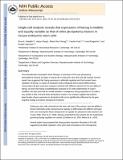Single-Cell Analysis Reveals that Expression of Nanog Is Biallelic and Equally Variable as that of Other Pluripotency Factors in Mouse ESCs
Author(s)
Wang, Haoyi; Cheng, Albert Wu; Katz, Yarden; Buganim, Yosef; Jaenisch, Rudolf; Faddah, Dina A.; ... Show more Show less
DownloadJaenisch_Single-cell analysis.pdf (861.4Kb)
PUBLISHER_CC
Publisher with Creative Commons License
Creative Commons Attribution
Terms of use
Metadata
Show full item recordAbstract
The homeodomain transcription factor Nanog is a central part of the core pluripotency transcriptional network and plays a critical role in embryonic stem cell (ESC) self-renewal. Several reports have suggested that Nanog expression is allelically regulated and that transient downregulation of Nanog in a subset of pluripotent cells predisposes them toward differentiation. Using single-cell gene expression analyses combined with different reporters for the two alleles of Nanog, we show that Nanog is biallelically expressed in ESCs independently of culture condition. We also show that the overall variation in endogenous Nanog expression in ESCs is very similar to that of several other pluripotency markers. Our analysis suggests that reporter-based studies of gene expression in pluripotent cells can be significantly influenced by the gene-targeting strategy and genetic background employed.
Date issued
2013-07Department
Massachusetts Institute of Technology. Computational and Systems Biology Program; Massachusetts Institute of Technology. Department of Biology; Massachusetts Institute of Technology. Department of Brain and Cognitive Sciences; Whitehead Institute for Biomedical ResearchJournal
Cell Stem Cell
Publisher
Elsevier
Citation
Faddah, Dina A., Haoyi Wang, Albert Wu Cheng, Yarden Katz, Yosef Buganim, and Rudolf Jaenisch. “Single-Cell Analysis Reveals That Expression of Nanog Is Biallelic and Equally Variable as That of Other Pluripotency Factors in Mouse ESCs.” Cell Stem Cell 13, no. 1 (July 2013): 23–29.
Version: Author's final manuscript
ISSN
19345909